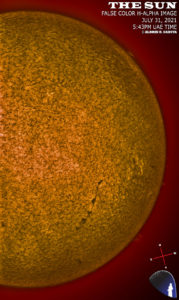Here is today’s white-light solar image taken from Al Sadeem Observatory, July 4, 2020.
The sky was mostly clear but with intermittent moderate winds which provided good transparency but average seeing at the time these images were taken.
The Sun has remained generally inactive over the past 24 hours, on its 6th consecutive day. A small enhanced area of pores has recently emerged near the Sun’s equator along the eastern quadrant (encircled). No significant flaring activity was recorded. The latest sunspot number (based on visual count and Wolf number calculation) is 2. The Sun also exhibited multiple plasma ejection activities through the presence of some huge eruptive prominences at the opposite limbs (including multiple ones at the southeastern limb which is about 75,000 km high), several huge stable filaments at the Sun’s northern hemisphere and the decaying remnant plage of Catania sunspot group 33 transiting the Sun’s disk at the far southern hemisphere as distinctively captured in H-alpha imagery.
Space weather agencies* forecast solar activity to remain at very low levels with chances of weak X-ray fluxes or flares up to B-class intensity. Close monitoring is being conducted by numerous space weather agencies for any significant development.
Equipment used are Skywatcher 120mm refractor telescope with Baader filter and unmodified Canon EOS 1D Mark IV DSLR camera for visible imagery. Pre-processing of visible solar images was performed in PIPP, stacking in Autostakkert, slight wavelet adjustments in Registax 6, and post-processing in Adobe Photoshop CC.
*TECHNICAL REPORTS COURTESY OF SOLAR INFLUENCE DATA CENTER (SIDC), NOAA-SPACE WEATHER PREDICTION CENTER (NOAA-SWPC)
Weather Data (5:35 PM – 5:55 PM, July 4, 2020, from NCM Al Wathba Station):
Average Temperature: 43.6°C
Average Humidity: 26.33%
Average Wind Speed and Direction: 23.9 kph from NNW
Average Cloud Cover: 5%
Average Air Pressure: 983.33 hPa
Average Solar Radiation: 178.33 W/m^2








